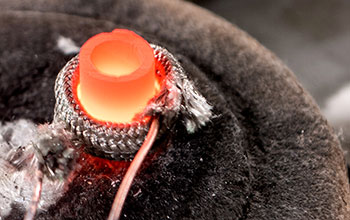Multimedia Gallery
Technique converts bulk alloys to oxide nanowires
Researchers at the Georgia Institute of Technology have developed a low-cost technique for converting bulk powders directly to oxide nanowires. Shown here is a crucible in which an alloy of lithium and aluminum is being formed.
More about this image
A simple technique for producing oxide nanowires directly from bulk materials
could dramatically lower the cost of producing 1-D nanostructures which could in turn, open the door for a broad range of uses in lightweight structural composites, advanced sensors, electronic devices and thermally-stable and strong battery membranes able to withstand temperatures of more than 1,000 degrees Celsius.
The technique uses a solvent reaction with a bimetallic alloy--in which one of the metals is reactive--to form bundles of nanowires (nanofibers) upon reactive metal dissolution. The process is conducted at ambient temperature and pressure without the use of catalysts, toxic chemicals or costly processes such as chemical vapor deposition. The produced nanowires can be used to improve the electrical, thermal and mechanical properties of functional materials and composites.
The process is believed to be the first to convert bulk powders to nanowires at ambient conditions.
This research was supported in part by the National Science Foundation (grant DMR 09-54925).
To learn more about this research, see the Georgia Tech news story New Low-Cost Technique Converts Bulk Alloys to Oxide Nanowires. (Date image taken: January 2017; date originally posted to NSF Multimedia Gallery: March 24, 2017)
Credit: Georgia Institute of Technology
See other images like this on your iPhone or iPad download NSF Science Zone on the Apple App Store.
Images and other media in the National Science Foundation Multimedia Gallery are available for use in print and electronic material by NSF employees, members of the media, university staff, teachers and the general public. All media in the gallery are intended for personal, educational and nonprofit/non-commercial use only.
Images credited to the National Science Foundation, a federal agency, are in the public domain. The images were created by employees of the United States Government as part of their official duties or prepared by contractors as "works for hire" for NSF. You may freely use NSF-credited images and, at your discretion, credit NSF with a "Courtesy: National Science Foundation" notation.
Additional information about general usage can be found in Conditions.
Also Available:
Download the high-resolution JPG version of the image. (3.3 MB)
Use your mouse to right-click (Mac users may need to Ctrl-click) the link above and choose the option that will save the file or target to your computer.



